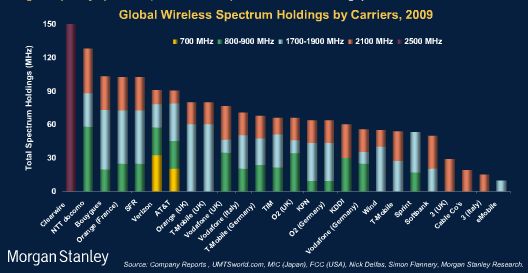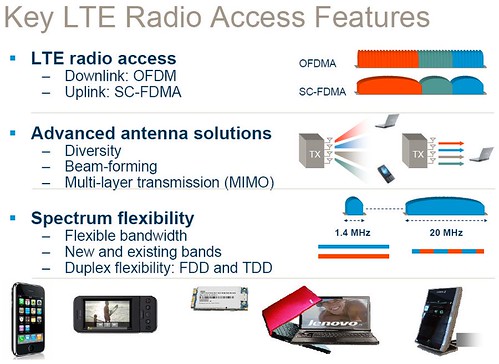Mr. Incredible: I was wrong to treat you that way. I’m sorry…
Syndrome: See? Now you respect me, because I’m a threat. That’s the way it works. Turns out there are lots of people, whole countries, that want respect.
– The Incredibles
 The GSM Association, in a report issued today, argues that the majority of the 2.6GHz band should be devoted to their LTE system, and not competitors like WiMAX.
The GSM Association, in a report issued today, argues that the majority of the 2.6GHz band should be devoted to their LTE system, and not competitors like WiMAX.
The GSMA’s report (pdf), represents GSM-based cellular operators. Cellular operators are generally committed to voice-centric LTE, not data-centric WiMAX.
WiMAX supporters say their TDD-based system is more efficient – one channel isn’t wasted “listening”, and one channel works better with multiple antennas. WiMAX can be asymmetrical – good for data which comprises most of the traffic in a “4G” system – and can use beamforming more effectively. Cellular operators say FDD-based LTE is voice-centric – and that’s a good thing. It’s the way the world works. Besides, they need the spectrum.
The 2.6 GHz band, which runs from 2.5GHz to 2.69GHz, was allocated worldwide for mobile communications in 2000, when it was expected that 3G services would expand there. GSMA says door number 3, the “Flexible” option, as a practical matter, may cause interference problems with adjoining carriers using different systems.
In option one, four different LTE carriers could bid on the FDD spectrum in one region, in blocks of 10 MHz or 20 MHz. The middle portion of the band has 50MHz dedicated to TDD-based WiMAX. This approach has been the preferred option by many national telephone governing boards, because it encourages competition between LTE and WiMAX carriers. GSMA argues that approach will be inefficient if WiMAX is unpopular.
In the USA and Canada, much to the disdain of the GSMA, Clearwire and Sprint have accumulated nearly all the 2.6 GHz spectrum. GSMA says that “at some point it may well become desirable to make better use of the 2.6GHz band in the United States than is represented by the current investments of Clearwire and Sprint Nextel”.
The GSMA’s Conclusions:
- Evidence generally indicates more demand for paired than unpaired spectrum at 2.6 GHz.
- ITU Option 2 can be ruled out and Option 3 presents many challenges.
- Growing momentum to adopt ITU Option 1 has developed in Europe.
- Rational analysis concludes that ITU Option 1 best meets all stakeholder objectives.
AT&T and Verizon would like to pressure the U.S. government to help them get some of Sprint’s spectrum – never mind that both cellcos are sitting on their unused AWS spectrum and lots more is available from SpectrumCo, the cable consortium. Cable operators later joined Clear’s WiMAX venture, so their AWS frequencies are sitting unused.
 In other LTE news: TeliaSonera AB, which announced the first commercial LTE service last month in Sweden, today announced its vendor selection for nationwide network rollouts in Sweden and Norway.
In other LTE news: TeliaSonera AB, which announced the first commercial LTE service last month in Sweden, today announced its vendor selection for nationwide network rollouts in Sweden and Norway.
 A combination of Ericsson and Nokia gear will provide the access infrastructure. TeliaSonera chose Ericsson AB and China-based Huawei last year to build initial metro networks in Stockholm, Sweden, and Oslo, but its widespread LTE rollouts — with 25 municipalities in Sweden and and four in Norway — are likely to go to Scandinavian companies.
A combination of Ericsson and Nokia gear will provide the access infrastructure. TeliaSonera chose Ericsson AB and China-based Huawei last year to build initial metro networks in Stockholm, Sweden, and Oslo, but its widespread LTE rollouts — with 25 municipalities in Sweden and and four in Norway — are likely to go to Scandinavian companies.
TeliaSonera became the first operator in the world to launch LTE commercially last month and has three nation wide 4G/LTE licenses; in Sweden, Norway and Finland. TeliaSonera’s LTE service will cover around 400,000 people in the centres of Stockholm and Oslo. It will first introduce the services in the largest cities in Sweden and Norway, followed by sites in Finland, where it recently received an LTE license. TeleSonera said it hopes to get the license for a Danish rollout early in 2010.
 Verizon Wireless says it expects to commercially launch its LTE 4G network in up to 30 markets in 2010, covering 100 million people with full nationwide coverage in 2013. The company successfully completed its first Long Term Evolution (LTE) data call in Boston, in August, 2009, using 3GPP Release 8. The company also completed an LTE 4G data call in Seattle. Verizon says its LTE network will deliver speeds between 5 Mbps and 12 Mbps.
Verizon Wireless says it expects to commercially launch its LTE 4G network in up to 30 markets in 2010, covering 100 million people with full nationwide coverage in 2013. The company successfully completed its first Long Term Evolution (LTE) data call in Boston, in August, 2009, using 3GPP Release 8. The company also completed an LTE 4G data call in Seattle. Verizon says its LTE network will deliver speeds between 5 Mbps and 12 Mbps.
The difference between Verizon and TeliaSonera is that Verizon is using the 700 MHz band and has 10 MHz of radio spectrum each for the uplink and the downlink. TeliaSonera is using the 2.6 GHz band and has 20 MHz available for each channel.
Verizon’s “C” Block, with two 11 Mhz channels, was the largest swath of airwaves at 700 MHz and covers the entire continental U.S. plus Hawaii. AT&T’s licenses do not blanket the country as Verizon’s do. The C Block’s open-access provision was initially championed by Google, but Verizon ended up buying the spectrum for $4.6 billion.
Both LTE and WiMAX use OFDM, which mitigates the effects of self-interference, when each sector uses the same 10 MHz frequency. At 700 MHz, however, self interference could be significant, reducing effective data rates. Verizon projects 5 Mbps to 12 Mbps speeds, similar to Sprint’s Mobile WiMAX.
In the next few years Mobile WiMAX 2.0 (802.16m) may effectively double Clear’s speed. Verizon and AT&T don’t have anywhere to go. They can’t fit two, 20 Mhz channels in the current band. Clearwire, of course, is aware of this situation. They can win either way. Fire and brimstone is just part of the process.
The primary difference between WiMAX and LTE is the SC-FDMA uplink. Both standards accommodate channel bandwidths that vary from 1.25 to 20 MHz. WiMAX 2.0 (120 Mbps), likely to be trialed in some Clear cities this year in 2011, uses one 20 MHz channel. LTE, to achieve 120 Mbps speeds, needs two, 20 Mhz channels. Verizon doesn’t have the capacity on either the 700 MHz or AWS bands. AT&T and Verizon, presumably, may be gently lobbying for access to Sprint’s spectrum through this GSMA study.
Cisco demonstrated its mobility solutions incorporating technology from Starent Networks, along with Verizon Wireless, during the 2010 International Consumer Electronics Show in Las Vegas. With Starent, Cisco is a proponent of LTE technology.
 As a co-participant in Verizon Wireless’ LTE Innovation Center, Cisco provided support to many LTE demonstrations which employ its Packet Data Network Gateway solution. Both Cisco and Starent Networks (News – Alert) have a history of a long association with Verizon Wireless. In February 2009, Verizon chose Starent Networks as one of its mobile core vendors for its 4G LTE network installations and is also employing its multimedia core network equipment to provide next-generation multimedia applications to consumers.
As a co-participant in Verizon Wireless’ LTE Innovation Center, Cisco provided support to many LTE demonstrations which employ its Packet Data Network Gateway solution. Both Cisco and Starent Networks (News – Alert) have a history of a long association with Verizon Wireless. In February 2009, Verizon chose Starent Networks as one of its mobile core vendors for its 4G LTE network installations and is also employing its multimedia core network equipment to provide next-generation multimedia applications to consumers.
Verizon recently also chose Starent’s Gateway GPRS Support Node (GGSN) as part of its mobile core infrastructure. This also signaled the next step in installing its LTE 4G wireless network, which is being created on the 3GPP Release 8 standard.
Verizon Wireless’ network brings together Cisco technologies, like the Cisco CRS-1 Carrier Routing System, Cisco ASR 9000 Series Routers, Cisco ASR 1000 Series Routers and the Starent ST-series to build both capacity and capabilities of backhaul and packet core for its 3G/4G mobile Internet offerings.
Research and Markets expects that over time, there will be a broader device ecosystem for LTE than for WiMAX. LTE deployments can reuse legacy network infrastructure in more cases than WiMAX and will have more opportunities to partner with others to lower deployment and operating costs.
By 2014, they estimate about 53m WiMAX subscribers worldwide, up from 5.5m at year-end 2009. LTE will reach 181m subscriptions by 2014, growing faster than any preceding mobile technology, says Research and Markets. Different research firms have different projections on the relative growth of LTE vrs WiMAX (perhaps depending on who funds the study).
source : dailywireless.org
 Mobile Portland tonight features two speakers who are early innovators in augmented reality. P. Mark Anderson is the platform architect for Spot Metrix which provides an augmented reality library for iPhone called 3DAR. The second speaker, Tim Sears, created Robotvision, one of the first augmented reality applications for iPhone.
Mobile Portland tonight features two speakers who are early innovators in augmented reality. P. Mark Anderson is the platform architect for Spot Metrix which provides an augmented reality library for iPhone called 3DAR. The second speaker, Tim Sears, created Robotvision, one of the first augmented reality applications for iPhone.















































